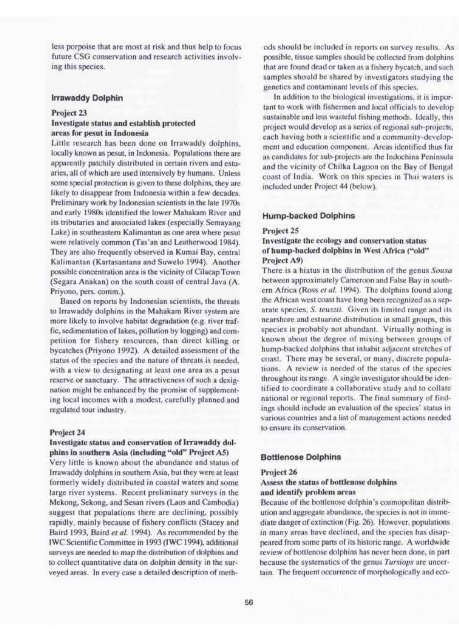Dolphins, Porpoises, and Whales - IUCN
Dolphins, Porpoises, and Whales - IUCN
Dolphins, Porpoises, and Whales - IUCN
You also want an ePaper? Increase the reach of your titles
YUMPU automatically turns print PDFs into web optimized ePapers that Google loves.
less porpoise that are most at risk <strong>and</strong> thus help to focus<br />
future CSG conservation <strong>and</strong> research activities involving<br />
this species.<br />
Irrawaddy Dolphin<br />
Project 23<br />
Investigate status <strong>and</strong> establish protected<br />
areas for pesut in Indonesia<br />
Little research has been done on Irrawaddy dolphins,<br />
locally known as pesut, in Indonesia. Populations there are<br />
apparently patchily distributed in certain rivers <strong>and</strong> estuaries,<br />
all of which are used intensively by humans. Unless<br />
some special protection is given to these dolphins, they are<br />
likely to disappear from Indonesia within a few decades.<br />
Preliminary work by Indonesian scientists in the late 1970s<br />
<strong>and</strong> early 1980s identified the lower Mahakam River <strong>and</strong><br />
its tributaries <strong>and</strong> associated lakes (especially Semayang<br />
Lake) in southeastern Kalimantan as one area where pesut<br />
were relatively common (Tas'an <strong>and</strong> Leatherwood 1984).<br />
They are also frequently observed in Kumai Bay, central<br />
Kalimantan (Kartasantana <strong>and</strong> Suwelo 1994). Another<br />
possible concentration area is the vicinity of Cilacap Town<br />
(Segara Anakan) on the south coast of central Java (A.<br />
Priyono, pers. comm.).<br />
Based on reports by Indonesian scientists, the threats<br />
to Irrawaddy dolphins in the Mahakam River system are<br />
more likely to involve habitat degradation (e.g. river traffic,<br />
sedimentation of lakes, pollution by logging) <strong>and</strong> competition<br />
for fishery resources, than direct killing or<br />
bycatches (Priyono 1992). A detailed assessment of the<br />
status of the species <strong>and</strong> the nature of threats is needed,<br />
with a view to designating at least one area as a pesut<br />
reserve or sanctuary. The attractiveness of such a designation<br />
might be enhanced by the promise of supplementing<br />
local incomes with a modest, carefully planned <strong>and</strong><br />
regulated tour industry.<br />
Project 24<br />
Investigate status <strong>and</strong> conservation of Irrawaddy dolphins<br />
in southern Asia (including "old" Project A5)<br />
Very little is known about the abundance <strong>and</strong> status of<br />
Irrawaddy dolphins in southern Asia, but they were at least<br />
formerly widely distributed in coastal waters <strong>and</strong> some<br />
large river systems. Recent preliminary surveys in the<br />
Mekong, Sekong, <strong>and</strong> Sesan rivers (Laos <strong>and</strong> Cambodia)<br />
suggest that populations there are declining, possibly<br />
rapidly, mainly because of fishery conflicts (Stacey <strong>and</strong><br />
Baird 1993, Baird et al. 1994). As recommended by the<br />
IWC Scientific Committee in 1993 (IWC 1994), additional<br />
surveys are needed to map the distribution of dolphins <strong>and</strong><br />
to collect quantitative data on dolphin density in the surveyed<br />
areas. In every case a detailed description of meth<br />
56<br />
ods should be included in reports on survey results. As<br />
possible, tissue samples should be collected from dolphins<br />
that are found dead or taken as a fishery bycatch, <strong>and</strong> such<br />
samples should be shared by investigators studying the<br />
genetics <strong>and</strong> contaminant levels of this species.<br />
In addition to the biological investigations, it is important<br />
to work with fishermen <strong>and</strong> local officials to develop<br />
sustainable <strong>and</strong> less wasteful fishing methods. Ideally, this<br />
project would develop as a series of regional sub-projects,<br />
each having both a scientific <strong>and</strong> a community-development<br />
<strong>and</strong> education component. Areas identified thus far<br />
as c<strong>and</strong>idates for sub-projects are the Indochina Peninsula<br />
<strong>and</strong> the vicinity of Chilka Lagoon on the Bay of Bengal<br />
coast of India. Work on this species in Thai waters is<br />
included under Project 44 (below).<br />
Hump-backed <strong>Dolphins</strong><br />
Project 25<br />
Investigate the ecology <strong>and</strong> conservation status<br />
of hump-backed dolphins in West Africa ("old"<br />
Project A9)<br />
There is a hiatus in the distribution of the genus Sousa<br />
between approximately Cameroon <strong>and</strong> False Bay in southern<br />
Africa (Ross e< a/. 1994). The dolphins found along<br />
the African west coast have long been recognized as a separate<br />
species, S. teuszii. Given its limited range <strong>and</strong> its<br />
nearshore <strong>and</strong> estuarine distribution in small groups, this<br />
species is probably not abundant. Virtually nothing is<br />
known about the degree of mixing between groups of<br />
hump-backed dolphins that inhabit adjacent stretches of<br />
coast. There may be several, or many, discrete populations.<br />
A review is needed of the status of the species<br />
throughout its range. A single investigator should be identified<br />
to coordinate a collaborative study <strong>and</strong> to collate<br />
national or regional reports. The final summary of findings<br />
should include an evaluation of the species' status in<br />
various countries <strong>and</strong> a list of management actions needed<br />
to ensure its conservation.<br />
Bottlenose <strong>Dolphins</strong><br />
Project 26<br />
Assess the status of bottlenose dolphins<br />
<strong>and</strong> identify problem areas<br />
Because of the bottlenose dolphin's cosmopolitan distribution<br />
<strong>and</strong> aggregate abundance, the species is not in immediate<br />
danger of extinction (Fig. 26). However, populations<br />
in many areas have declined, <strong>and</strong> the species has disappeared<br />
from some parts of its historic range. A worldwide<br />
review of bottlenose dolphins has never been done, in part<br />
because the systematics of the genus Tursiops are uncertain.<br />
The frequent occurrence of morphologically <strong>and</strong> eco-

















